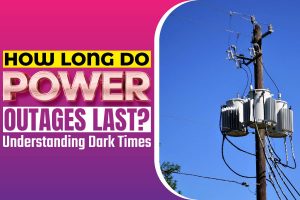Today’s society is completely reliant on electricity. Everything from banks, schools, emergency services and even the food industry relies on electricity to conduct their daily routines. It is horrifying to think of what our lives would be like without electricity.
Having said this, everyone dreads power outages. For whatever reason, you might lose power in your area, nobody wants it, and everyone is anxious for the power to be back.
So let us get into the topic and give you details of exactly when you can expect your power back;
How Long Does Power Outages Last?
The exact length of an outage will depend on what caused it. Normally, a power outage will get resolved by the power company in less than two days. However, depending on the cause, this period can extend to more days or even several weeks.
An ice storm, tornado or tsunami could damage power lines for miles; thus, it will take a lot of time for the repairs to get done safely, which means you will be in the dark longer. The damage done to the cable is the determining factor.
How Do Power Outages Happen?
Power outages are rare in most areas in the US, but they happen at any time. It could be in the middle of a violent storm or a sunny day. You will be watching TV; then, suddenly, you are in total darkness.
A power outage can be caused by something as simple as a tree branch falling on a power line. There could be strong winds in the area, and the wind might end up breaking a few branches or pulling out a whole tree and dropping it into a power line.
Lightning strikes are very powerful, and they can do severe damage to electrical equipment. For this reason, power companies have a safety feature in their systems.
If a strike is too close to a transformer, the safety feature kicks in instead of exploding and causes a blackout.
This blackout can be fixed in a matter of minutes, and you will get your power back. This is better than having the transformer blow up along with every building connected to it, which would cause billions in damage.
Another major cause of outages is wild animals. Squirrels are the reason for over 20% of all power outages in the US.
Power companies do a lot to prevent animals from getting to power lines, but it happens very often, and they damage the lines or equipment.
Extreme temperatures can also cause a power outage. Extreme heat can damage heat-sensitive equipment and cause short circuits, which will lead to a power outage. The cold poses a danger to the lines themselves.
Ice from an ice storm can accumulate on a power line and freeze it. The reduced temperature combined with the additional weight of the ice can break the lines, and they will fall. The weight of the ice could also cause nearby trees to fall onto power lines.
How To Survive A Power Outage
Being as reliant on electricity as we are, it seems impossible to imagine a week without power in your house.
How could you go without power with so many appliances that need electricity, such as the heater, the refrigerator, cookers, and other appliances? Let me give you some tips you can use to improvise solutions to survive a power outage;
- Most people have solar-powered lights outside their homes to light the backyard or walkways. Where there is a power outage, you can take these lights into the house and use the light, then take it out to recharge the following day.
- You can also use a headlamp to light up a whole room. Take a clear water gallon and fill it with water, then tie the light around the gallon facing inside it. The water will reflect the light, and it will get dispersed all over your room.
- The refrigerator needs to keep your food cold and fresh even without power. You can achieve this by putting as many bags of ice in the fridge as you can so that the internal temperature of your fridge stays low and keeps the food fresh.
- If you don’t have a lot of ice, you could convert your washing machine into a freezer. Put some ice in the washing machine to cool it down; then put in all your perishable items. The freezer is air-tight; thus, your food will stay cold, and the melting ice won’t be an issue since a washing machine is designed to deal with water.
- Our phones are important; you should have a fix for charging your phone. You can use the emergency jump starter for your car to charge your phone battery so you can keep up with work or anything else you need your phone for.
- When there is no power, you will have a problem with cold since most outages come during winter. You need to maintain high temperatures inside your hour, and if you don’t have a fireplace, you can do it by keeping the cold out. The simplest way to keep the cold out is by insulating the windows and other open places. For the windows, spray some water on them, then cut bubble wrap of appropriate sizes and put it on the windows. Press on the wrap gently, and it will stick, insulating your home.
- As a general precaution, you need to get more solar-powered backup equipment and even install skylights. Having a solar-powered cooker, light and battery will give you a sure backup so you can do all the basics even without power.
How Are Power Outages Fixed?
Most of us expect the power to be back just a few hours after it goes out. However, this is not the case at all times since major storms could cause serious damage to many infrastructures, which would take a long time to fix.
Luckily, electrical workers toil long hours to ensure you safely get the power back as soon as possible.
They have to make sure everyone gets power, and there are no risks of accidents; thus, they follow the following steps in restoring power;
- Repair of High Voltage Transmission Lines. Transmission lines and towers are used to transmit power to thousands of users. For this reason, they are built strong to withstand rough weather.
- It is rare for them to fall, but when they do, they have to be fixed before other electrical grid components can work. This is because all other components depend on the transmission lines.
- Inspecting distribution substations. These are the locations that receive the high voltage from transmission cables. They step down the voltage and then distribute it to distribution lines.
- Each of these locations can serve hundreds or thousands of people, depending on the location. The substation has to be inspected to ensure no issues and confirm that the transmission lines are working correctly.
- If the substation and the main transmission lines are okay, the repair crew will inspect the lower parts of the system. Any problems spotted in the subsystem will get fixed before the crew moves on.
- Checking the main distribution lines. If the distribution substation is working correctly, the lines coming from the substation are checked. The storm could have damaged the electricity poles or lines; thus, they can’t transmit power.
- All the lines will be repaired, and any poles that need to be replaced will be replaced. These lines are vital in the power grid since they move power from the substation to the specific neighborhood so that the power gets to you.
- Inspecting the tap lines. These are the power lines that connect your home to a nearby transformer or pole. They are found outside homes, businesses or any other point that consumes power.
Trees could fall on these lines and cut them or get disconnected; thus, some people in the same neighborhood have power while others don’t. Once your tap line is fixed, you will get your power back just like everyone else.
These processes can all happen simultaneously to save on time since power is important. It is a job that requires a lot of skill and time to keep all users satisfied and safe.
Conclusion
The time it takes before the power comes back during an outage depends on the cause of the outage.
If floods or heavy rains damaged the cables, the outage would persist until the weather changes and repair crews can work.
The extent of damage will also determine how long you will stay in the dark. If numerous lines and posts are destroyed, you will have to wait for a longer time for them to get fixed. Power companies work overtime to restore power as fast and as safely as possible.
You can improvise with camping equipment and anything else you can come up with to survive the blackout.
The most important thing is to disconnect all your equipment from the outlets so that you keep them and yourself safe from power surges.





















